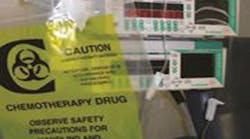Healthcare workers who prepare or give hazardous drugs to patients, such as those used for cancer therapy, as well as support staff may face individual health risks when exposed to these drugs, warns the National Institute for Occupational Safety and Health (NIOSH).
“NIOSH List of Antineoplastic and other Hazardous Drugs in Healthcare Settings 2014” is the latest version of the hazardous drug list first published by NIOSH in 2004 as an appendix to the document, “NIOSH Alert: Preventing Occupational Exposure to Antineoplastic and Other Hazardous Drugs in Health Care Settings.”
Hazardous drugs on the list include those used for cancer chemotherapy, antiviral drugs, hormones, some bioengineered drugs and other miscellaneous drugs.
“Millions of American workers in healthcare facilities may come into contact with drugs that are capable of causing serious health effects such as cancer, fertility problems, and organ damage,” said NIOSH Director John Howard, M.D. “This list is an important resource to help workers be aware of the hazards certain drugs pose so they can take the necessary steps to protect themselves from exposure while doing their job.”
The current list is comprised of drugs that NIOSH systematically has reviewed according to the criteria in the NIOSH definition of a hazardous drug. The latest version of the list includes 27 drugs not found on previous lists, and 12 drugs were removed that did not meet NIOSH’s criteria for hazardous drugs. NIOSH made previous updates to the list in 2012 and 2010.
Additionally, the new document provides healthcare organizations with information on how to generate a list of hazardous drugs specific to their workplace as well as resources for evaluating the hazard potential of a drug. NIOSH also offers an alert that provides more information and recommendations on methods and personal protective equipment (PPE) to minimize exposure to hazardous drugs.

